Berwyn - Y Berwyn National Nature Reserve, Near Bala, Wales
Designations: within the Berwyn SSSI and SPA; Berwyn and South Clwyd Mountains SAC
Below: Pistil Rhaeadr - one of the access points to The Berwyn NNR
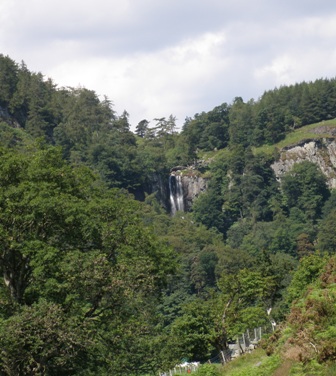
Berwyn National Nature Reserve is huge, covering some 8000 hectares. The reserve is made up of seven separate locations, by far the largest of which is Lake Vyrnwy RSPB/Severn Trent Water Nature Reserve, which covers some 4,200 hectares of the Berwyn range.
More details about Lake Vyrnwy RSPB and Severn Trent Water Nature Reserve... within Y Berwyn NNR.
The other sections, managed by the Countryside Council for Wales (CCW), are Palé (3800 hectares), Buarth Yr E (37 hectares), Drum ddu (20 hectares), Haford Hir (35 hectares), Pen y Gelli (137 hectares) and Nant Y Dugoed (166 hectares).
Y Berwyn NNR covers nearly 8,000 hectares of open moorland within the Berwyn Mountain range, and this vast area is not only home to many wildlife species, it also has a rich archaeological heritage.
Directions
Apart from access via Lake Vyrnwy NNR there is also access to The Berwyn from several other locations:
Pistil Rhaeadr
This entry to the Berwyns is via a path leading to a spectacular waterfall about eight km (five miles) from the village of Llanrhaeadr-ym-Mochnant.
From Welshpool take the A490 which passes through Llanfyllin and then look out for a right hand-turn onto the B4391, which will take you to the small village of Llanrhaeadr-ym-Mochnant.
From the village take the turn signed to the Waterfall and continue up a steep and very narrow lane with occasional passing places until you reach the car park at the end of the road. There are a café and public toilets
Cars can be parked adjacent to the café on a 'pay and display' basis.
Llandrillo
Below: Llandrillo access - over the humpback bridge and turn right into Heol y Berwyn
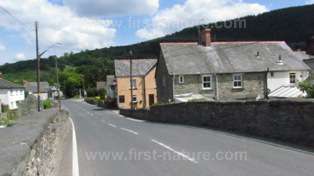
From Bala take the A494 towards Corwen and then turn right almost immediately onto the B4401 towards the village of Llandrillo.
Once in the village of Llandrillo turn right just after the humpback bridge into Heol Y Berwyn (Berwyn Street) and park as soon as you can. From here you can walk up the hill and into Y Berwyn National Nature Reserve. Do not attempt to take you car any further up the hill as the road soon becomes a very rough and rutted track.
Hendwr
From Bala take the A494 towards Corwen and then turn right almost immediately onto the B4401 towards Llandrillo.
Continue through Llandrillo on the B4401 towards Corwen, and after approximately 1.5km (one mile) you will see a sign on the left-hand side of the road for Hendwr Caravan Site. Turn right immediately opposite the entrance to the caravan site.
There is a post box on the right hand side of the lane as you turn, and this is a useful landmark. Continue up the hill for approximately 3/4km (half a mile). There is a parking area from which you can then walk up onto the mountain.
Below: Hendwr access - turn right opposite the caravan site
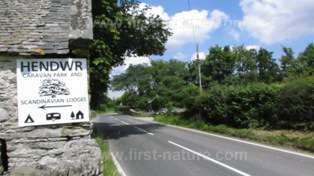
Access
Several walks and tracks within the NNR can be accessed from the entry points described above, but open moorland is challenging to walk on if you stray from the paths, and there are areas of dense heather covering rocks and boulders and very boggy ground lying in wait for the less cautious explorer. It is hazardous terrain; you have been warned!
Facilities
There are a number of helpful information boards close to the RSPB Visitor Centre at Lake Vyrnwy, and these show not only the trails but also the bird species that you can expect to see in the immediate area. There are also a café, public toilets and a shop at the Centre.
At the Pistil Rhaeadr entrance there are public toilets and a café at the car park.
There are no facilities at the other entrances to Y Berwyn NNR, but there are toilets, shops and pubs in nearby Llandrillo.
Description of Site
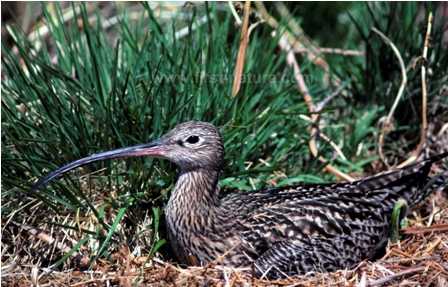
The Curlew, one of the birds that breed in The Berwyn NNR
picture: Mike Alexander CCW
Berwyn National Nature Reserve comprises a vast area of upland moorland stretching from near Llangollen in the north to Mallwyd in the south. The area includes a number of important wildlife habitats including woodland, dry heath, blanket bog, grassland, screes, cliffs and quarries.
In between the very varied land features there are numerous small ponds, lakes and streams that contribute much to the diversity that characterises this increasingly rare type of upland heather moorland
Some of the species that live in the Berwyn NNR are in steep decline in other parts of Britain due, mainly, to the impact of the agricultural and forestry industries in those places.
Berwyn NNR provides breeding habitat for numerous upland bird species which include Red Grouse (Lagopus lagopus), Black Grouse (Tetrao tetrix), Curlew (Numenius arquata), Golden Plover (Pluvialis apricaria), Snipe (Gallinago gallinago), Dunlin (Calidris alpina), Short-eared Owl (Asio flammeus), Wheatear (Oenanthe oenanthe), Stonechat (Saxicola torquata), Raven (Corvus corax), Whinchat (Saxicola rubetra) and Ring Ouzel (Turdus torquatus). This nature reserve is also a great place for catching a glimpse of some of the raptors. Merlin (Falco columbarius), Peregrine Falcon (Falco peregrinus), Red Kite (Milvus milvus) and Hen Harrier (Circus cyaneus) are all recorded from the Berwyn National Nature Reserve area.
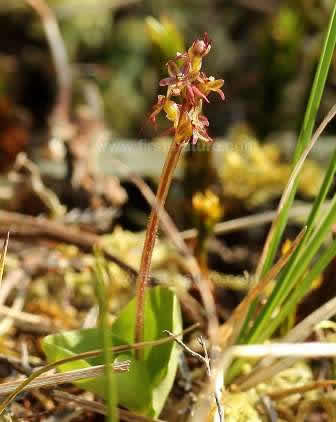 |
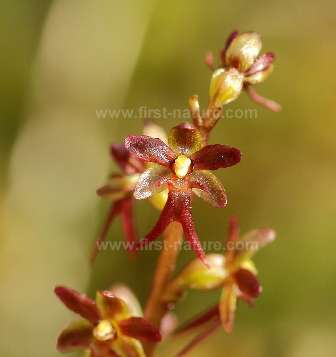 |
|---|
Pictured above: Lesser Twayblade, Neottia cordata - one of the rare orchids that grow in Berwyn NNR. Pictures by kind permission of Elaine Hagget...
Below: Bog Rosemary, Andromeda porrifolius, is another of the rare plants in Berwyn NNR
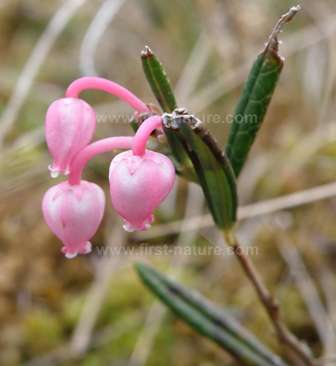
The woodlands in this area support important populations of Pied Flycatchers (Ficeudela hypoleuca), Nightjars (Caprimuglus europaeus), Bullfinches (Pyrrhula pyrrhula), Great Spotted Woodpeckers (Dendrocopus major) and Lesser Spotted Woodpeckers (Dendrocopus minor). Various projects are underway in and around the Berwyns to introduce more broadleaved trees into some of the conifer plantations in order to further enhance the opportunities for these birds to breed there.
In autumn and winter wildfowl arrive on the lakes in the Berwyn area; these incommers include Mallards, Teal and Little Grebes. Other parts of the reserve provide winter homes for Bramblings (Fringilla montifringilla), Fieldfares (Turdus pilaris) and Redwings (Turdus iliacus).
Areas of blanket bog occur on the deep peat that lies beneath the plants that we see on the surface of the mountain ridge-tops and plateaux. The peat has formed over the course of the many thousands of years since the last Ice Age, and the plant and animal remains that can be found in the peat are of great interest for research into the climate and environmental changes that have taken place in this part of Wales.
Without the right water level, which comes from the considerable rainfall the area experiences, the bog would not be able support the unique range of plants, insects and animals that now depend on it for their survival.
Plants that grow in blanket bog in The Berwyn include rare Bog Rosemary (Andromeda polifolia) and Tall Bog Sedge (Carex paupercula). Hare's-tail Cottongrass (Eriophorum vaginatum), Round-leaved Sundew (Drosera rotundifolia), various heathers, Bog Asphodel (Narthecium ossifragum) and peat-forming mosses such as Sphagnum Moss also grow in the blanket bog areas.
Below: The golden-coloured Cloudberry, much prized in northern Europe
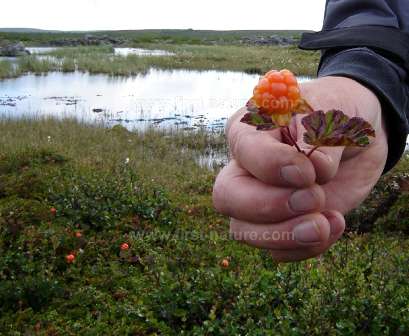
Cloudberries are another speciality of this area, although they do not grow in the vast quantities that provoke the 'Cloudberry Wars' that break out each year in some parts of northern Scandinavia, where rival gangs descend on the bogs in order to collect these fruits for the production of the famous Cloudberry jam.
If you have not tasted this prized delicacy it is possible to buy jars of Cloudberry jam in some of the Ikea stores now operating in many parts of the UK. Cloudberry plants (Rubus chamaemorus) resemble low-growing Blackberry plants except that the berries are a true golden colour that becomes darker as they ripen. The berries have quite large 'pips' which can be an irritation to those not completely signed up to the Cloudberry Culture. The most common way of serving this delicacy is simply to warm it through and then pour it over vanilla ice cream.
Although at first glance the open expanse of moorland on the mountain may look rather boring, Y Berwyn National Nature Reserve is home to many wildlife species, including various moths and butterflies. One rare moth that occurs in the area is the Welsh Clearwing Moth (Synanthedon scoliaeformis), whose caterpillars live inside mature birch trees. The Welsh Clearwing is a day-flying moth and the best time of year to catch sight of them is June and July, when the adult moths are out and about.